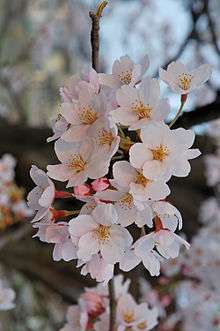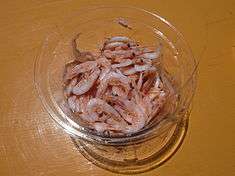Sakura shrimp
| Sakura shrimp | |
|---|---|
 | |
| Scientific classification | |
| Kingdom: | Animalia |
| Phylum: | Arthropoda |
| Subphylum: | Crustacea |
| Class: | Malacostraca |
| Order: | Decapoda |
| Suborder: | Dendrobranchiata |
| Family: | Sergestidae |
| Genus: | Lucensosergia |
| Species: | L. lucens |
| Binomial name | |
| Lucensosergia lucens (Hansen, 1922) | |
| Synonyms[1][2] | |
| |
Lucensosergia lucens is a species of shrimp popularly known as the sakura shrimp or sakura ebi. The translucent pink shrimp derives its name from sakura, the Japanese word for the cherry blossom. The species grows to about 4–5 cm and lives primarily in Suruga Bay in Shizuoka Prefecture, Japan, where it is caught to be eaten. It is also caught in Taiwan.
Taxonomy
The species name of the sakura shrimp has not been settled. The International Code of Zoological Nomenclature uses the designation Sergia kishinouyei that Nakazawa and Terao gave it in 1915. Researchers tend to use the Sergia lucens, which Danish zoologist Hans Jacob Hansen gave it in 1922, especially since Isabella Gordon published a detailed account of the species in On New Or Imperfectly Known Species of Crustacea Macrura in 1935 using Hansen's designation.[3] Hansen's designation comes from the genus Sergia and the Latin lucentis ("lighting"), likely referring to the sakura shrimp's phosphorescent photophores,[1] though the sakura shrimp has not been observed to emit light.[4]

The Japanese name sakura ebi (桜海老) translates as "cherry blossom shrimp"; it is so name because of the pink colour of the dried shrimp.[5]
Description
Members of Sergestes normally emit light, but the sakura shrimp has never been observed to do so, despite having photophores.[4]
Distribution, ecology, and behaviour
Sakura shrimp live in coastal areas, primarily in Suruga Bay in Shizuoka Prefecture, where they form in dense aggregations.[6] Suruga measures about 60 km long and 54 km at its greatest width;[7] at a depth of 2400 m, and with almost no continental shelf, it is the deepest and steepest of Japan's bays.[8] Sakura shrimp are also found in nearby Sagami and Tokyo Bays, but are not caught there as the populations are too sparse, perhaps because of insufficient depths of the bays.[6] In Taiwan the sakura shrimp is found in the coastal waters of Donggang and on the east coast. Findings have also been recorded in Borneo and New Guinea.[9]
Rather than crawling on the ocean floor as with other species of shrimp, the sakura shrimp spends its life floating in the water. During the day sakura shrimp scatter at a depth of 200–300 m; toward dusk they aggregate at a depth of about 60 m.[8]
The sakura shrimp has a lifespan of about 15 months, and matures a year after hatching. The adult can grow to 4–5 cm[8] and 0.4 g.[4] Until maturity the ratio of males to females is about equal. Upon reaching maturity males and females separate into groups, and as the females tend to group near the surface close to shore, the sex ratio changes around May to July.[10]
Spawning
Spawning occurs between late May and early November, but primarily in July and August when surface water temperatures are above 20 °C.[11] The ovaries stretch below the heart from the gastric region to the end of the back. As they mature they grow and change colour from yellow to milky blue and finally bluish-green at the time of spawning. The Sakura shrimp spawns an average of 1700–2300 eggs overnight far out in the bays. Distribution concentrates at a depth of about 20–50 m.[11] The eggs average 2.6 mm in circumference. They are not sticky and as they have a similar density to seawater they to float at about the place they were laid and spend life as a plankton.[11]
Harvest and consumption
 Boiled Sakura shrimp | |
| Nutritional value per 100g | |
|---|---|
| Energy | 1,305 kJ (312 kcal) |
|
0.1 g | |
| Dietary fibre | 0 g |
|
4.0 g | |
| Saturated | 0.59 g |
| Monounsaturated | 0.63 g |
| Polyunsaturated | 0.75 g |
|
64.9 g | |
| Vitamins | Quantity %DV† |
| Vitamin A equiv. |
0% 0 μg0% 0 μg |
| Thiamine (B1) |
15% 0.17 mg |
| Riboflavin (B2) |
13% 0.15 mg |
| Niacin (B3) |
37% 5.5 mg |
| Pantothenic acid (B5) |
23% 1.16 mg |
| Folate (B9) |
58% 230 μg |
| Vitamin B12 |
458% 11.0 μg |
| Vitamin C |
0% 0 mg |
| Vitamin D |
0% (0) μg |
| Vitamin E |
49% 7.3 mg |
| Vitamin K |
0% (0) μg |
| Minerals | Quantity %DV† |
| Calcium |
200% 2000 mg |
| Copper |
167% 3.34 mg |
| Iron |
25% 3.2 mg |
| Magnesium |
87% 310 mg |
| Phosphorus |
171% 1200 mg |
| Potassium |
26% 1200 mg |
| Sodium |
80% 1200 mg |
| Zinc |
52% 4.9 mg |
| Other constituents | Quantity |
| Water | 19.4 g |
| Colesterol | 700 mg |
| |
|
†Percentages are roughly approximated using US recommendations for adults. Source: USDA Nutrient Database | |
The Suruga fishery was established in 1894. During the two fishing periods of March to June and October to December the sakura shrimp are caught by trawling at night.[12]
Annual yields of sakura shrimp average 2000 tons in Suruga Bay and 100 tons in Donggang.[9] In Japan during the summer spawning months Sakura shrimp harvests are prohibited for conservation reasons.[11]
References
- 1 2 Vereshchaka, Olesen & Lunina 2014.
- ↑ "Sergia lucens". Integrated Taxonomic Information System. Retrieved 2015-03-24.
- ↑ Imai, Hanamura & Cheng 2013, pp. 123–124.
- 1 2 3 Shimomura 2012, p. 50.
- ↑ Omori 2002, p. 417.
- 1 2 Uchida & Baba 2008, p. 177.
- ↑ Omori & Ohta 1981, p. 107.
- 1 2 3 Uchida & Baba 2008, p. 176.
- 1 2 Imai, Hanamura & Cheng 2013, p. 124.
- ↑ Kubota 1999b, p. 26.
- 1 2 3 4 Kubota 1999b, p. 25.
- ↑ Bishop, Omori & Muranaka 1989, p. 243.
Works cited
- Bishop, Gretchen H.; Omori, Makoto; Muranaka, Fumio (1989). "Temporal and spatial variations in the spawning activity of the micronektonic shrimp, Sergia lucens (Hansen) in Suruga Bay, Japan". Journal of the Oceanographical Society of Japan. 45 (4): 243–250. doi:10.1007/BF02124873. ISSN 0029-8131.
- Imai, Hideyuki; Hanamura, Yukio; Cheng, Jin-Hua (2013). "Genetic and morphological differentiation in the Sakura shrimp (Sergia lucens) between Japanese and Taiwanese populations". Contributions to Zoology. 82 (3): 123–130.
- Kubota, Tadashi (1999). "Sakura-ebi no seibutsugaku" [The biology of Sakura shrimp]. In Ikematsu, Masato. Suruga-wan kara no okurimono Sakura-ebi 駿河湾からの贈りものサクラエビ [Sakura shrimp: A gift from Suruga Bay]. Kurofune Insatsu. pp. 5–24.
- Kubota, Tadashi (1999). "Sakura-ebi no seikatsu" [The life of Sakura shrimp]. In Ikematsu, Masato. Suruga-wan kara no okurimono Sakura-ebi 駿河湾からの贈りものサクラエビ [Sakura shrimp: A gift from Suruga Bay]. Kurofune Insatsu. pp. 21–34.
- Kubota, Tadashi (1999). "Sakura-ebi wo torimaku seibutsugun". In Ikematsu, Masato. Suruga-wan kara no okurimono Sakura-ebi 駿河湾からの贈りものサクラエビ [Sakura shrimp: A gift from Suruga Bay]. Kurofune Insatsu. pp. 35–44.
- Omori, Makoto; Ohta, Suguru (1981). "The use of underwater camera in studies of vertical distribution and swimming behaviour of a sergestid shrimp, Sergia lucens" (PDF). Journal of Plankton Research. 3 (1): 107–121. doi:10.1093/plankt/3.1.107.
- Omori, Makoto (2002). "One Hundred Years of Sergestid Shrimp Fishing Industry in Suruga Bay". In Benson, Keith Rodney; Rehbock, Philip F. Oceanographic History: The Pacific and Beyond. University of Washington Press. pp. 417–422. ISBN 978-0-295-98239-7.
- Shimomura, Osamu (2012). Bioluminescence: Chemical Principles and Methods. World Scientific. ISBN 978-981-4366-09-0.
- Uchida, H.; Baba, O. (2008). "Fishery management and the pooling arrangement in the Sakuraebi Fishery in Japan" (PDF). In Townsend, R.; Shotton, R.; Uchida, H. Case studies in fisheries self-governance (PDF). FAO. pp. 175–189. ISBN 978-92-5-105897-8.
- Vereshchaka, Alexander L.; Olesen, Jørgen; Lunina, Anastasia A. (2014). Valentine, John F., ed. "Global Diversity and Phylogeny of Pelagic Shrimps of the Former Genera Sergestes and Sergia (Crustacea, Dendrobranchiata, Sergestidae), with Definition of Eight New Genera". PLoS ONE. 9 (11): e112057. doi:10.1371/journal.pone.0112057. PMC 4237343. PMID 25409458.